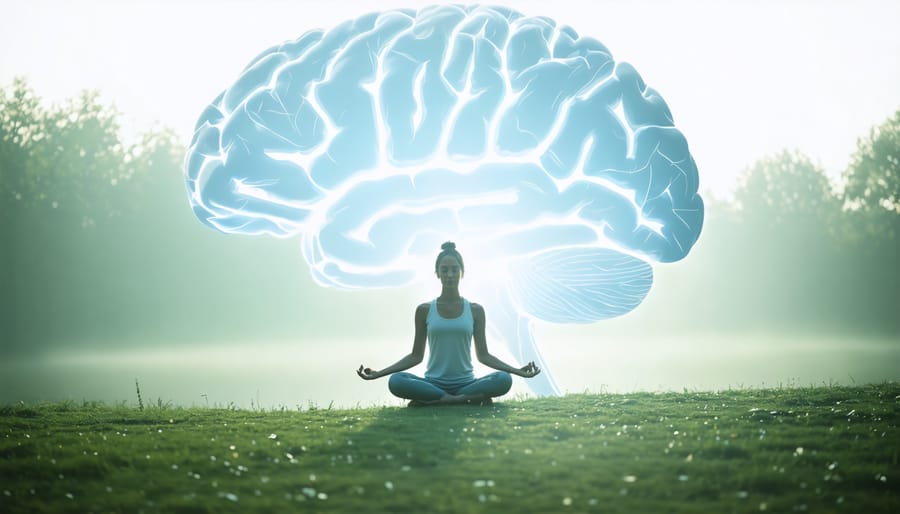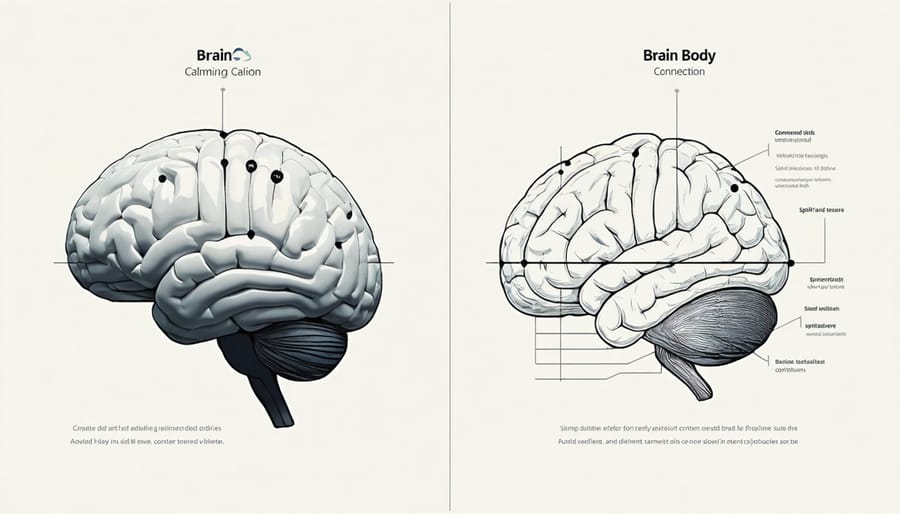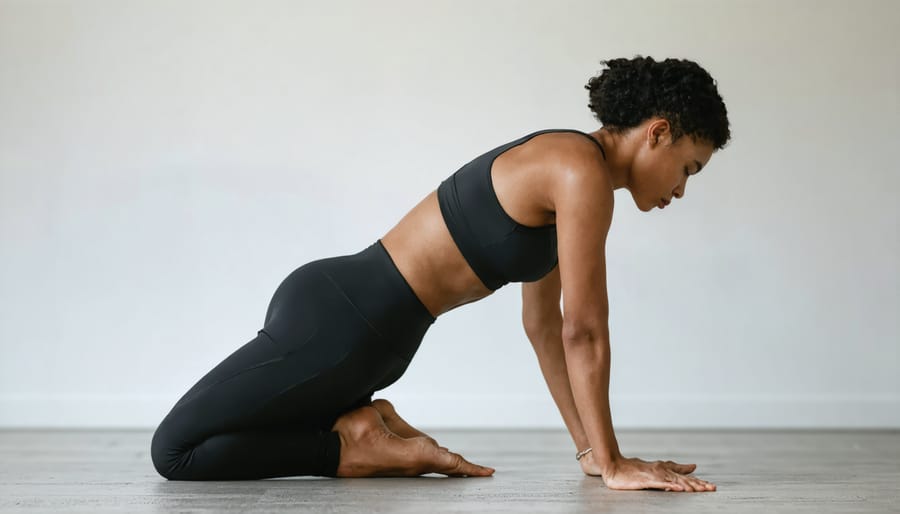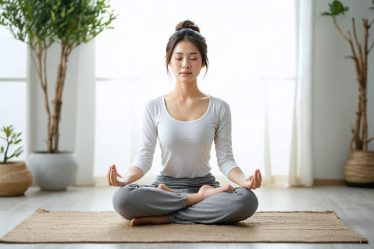
In a world where anxiety seems to follow us like a constant shadow, movement becomes our most powerful ally. Mindful movement – the practice of combining gentle physical activity with present-moment awareness – offers a natural pathway to calm our racing thoughts and ground ourselves in the here and now. Whether you’re dealing with occasional stress or chronic anxiety, this ancient-meets-modern approach transforms everyday movements into opportunities for healing and self-discovery.
Think of mindful movement as a bridge connecting your bustling mind to your breathing body. It’s not about perfecting yoga poses or mastering meditation techniques; it’s about finding freedom in simple actions like walking, stretching, or even washing dishes with complete awareness. This gentle yet powerful practice helps break the cycle of anxious thoughts by anchoring us in physical sensation and conscious breath.
As someone who’s witnessed countless clients transform their relationship with anxiety through mindful movement, I can tell you: the simplest steps often create the most profound changes. Let’s explore how this accessible practice can become your daily companion in managing anxiety and cultivating inner peace.
When Your Body Sends Anxiety Signals
Understanding Your Body’s Stress Response
Have you ever noticed how your heart races or your palms get sweaty when anxiety kicks in? These physical reactions aren’t random – they’re part of your body’s natural stress response system. When anxiety strikes, your body activates its “fight or flight” mode, releasing hormones like adrenaline and cortisol that prepare you for action.
Understanding these physical symptoms can be incredibly empowering. That tightness in your chest, the butterflies in your stomach, or the tension in your shoulders are all signals your body sends when it’s feeling overwhelmed. The good news? You can learn to work with these sensations rather than against them.
One effective way to tune into these physical responses is through mindful body scans, which help you identify where you’re holding tension and consciously release it. When you become more aware of your body’s stress signals, you can respond with gentle movement and breathing exercises before anxiety escalates.
Remember, these physical reactions aren’t something to fear – they’re your body’s way of communicating with you. By acknowledging and responding to these signals with compassion, you’re taking the first step toward managing anxiety more effectively.
The Mind-Body Disconnect
Have you ever felt like your mind and body are speaking different languages? When anxiety strikes, this disconnect becomes particularly noticeable. You might find your thoughts racing while your body feels frozen, or your muscles tensing up without any clear mental trigger. It’s like being a passenger in your own body, watching but not quite connecting with what’s happening.
This mind-body disconnect is more common than you might think. I remember teaching a yoga class where a student shared how she’d been so caught up in her anxious thoughts that she hadn’t realized she’d been holding her breath for what felt like minutes. This separation between our mental and physical experiences can make anxiety feel even more overwhelming.
When we’re anxious, our brain can get stuck in “protection mode,” creating a gap between what we’re thinking and what we’re physically experiencing. We might intellectually know we’re safe, but our body continues to send stress signals. Understanding this disconnect is the first step toward bridging the gap and finding ways to bring our mental and physical experiences back into harmony.

Simple Mindful Movement Practices

Gentle Morning Stretches
Starting your day with gentle stretches can be a game-changer for managing anxiety. As someone who used to wake up with a racing mind, I’ve discovered that incorporating these mindful practices into my morning routine has made a remarkable difference.
Begin by lying in bed and taking three deep breaths. Then, slowly stretch your arms overhead, imagining you’re reaching for your favorite morning treat. Gently hug your knees to your chest, one at a time, holding each position for 15-20 seconds. This simple movement helps release tension that builds up during sleep.
Next, stand beside your bed and perform a gentle forward fold, letting your arms hang loosely. Don’t worry about touching your toes – this isn’t about flexibility, but rather about listening to your body and releasing stress. Roll up slowly, vertebra by vertebra, taking time to notice how each movement feels.
Finally, try a gentle shoulder roll sequence: roll your shoulders forward five times, then backward five times. Follow this with neck rolls, moving your head in gentle half-circles from one shoulder to the other (avoid rolling backward).
Remember to breathe deeply throughout these stretches, and if any movement doesn’t feel right, skip it or modify it. The goal isn’t perfection – it’s creating a peaceful start to your day that honors both your body and mind.
Desk-Friendly Movement Breaks
When anxiety creeps in during your workday, you don’t need to stay glued to your chair. I’ve discovered some simple yet effective movement breaks that can help shake off those jitters without drawing too much attention or leaving your desk area.
Start with gentle shoulder rolls – I like to do these while waiting for files to load. Roll your shoulders forward five times, then backward five times. Next, try seated twists: keeping your feet planted, slowly rotate your torso to look over each shoulder, holding for three breaths on each side.
For those moments when you feel particularly tense, ankle and wrist rotations work wonders. Circle each joint five times in each direction – it’s amazing how such small movements can release full-body tension. If you have a private workspace, try seated cat-cow stretches: arch your back while looking up, then round it while looking down.
My personal favorite is what I call the “stealth stretch” – interlacing your fingers and reaching up toward the ceiling, then out in front of you. It’s subtle enough for any office setting but effectively releases upper body tension.
Remember to breathe deeply during these movements. Even taking just 60 seconds for any of these exercises can help reset your nervous system and bring you back to a calmer state. The key is consistency rather than duration – I find that shorter, more frequent movement breaks work better than occasional longer ones.

Creating Your Mindful Movement Routine
Starting Small: Building Sustainable Habits
When I first started incorporating mindful movement into my anxiety management routine, I learned that small steps lead to lasting changes. Think of it as planting a garden – you don’t expect everything to bloom overnight. Start with just five minutes of gentle stretching or mindful walking each day. The key is consistency rather than intensity.
Choose a specific time that works best for you, perhaps right after waking up or during your lunch break. Make it as natural as brushing your teeth. Begin with simple movements like shoulder rolls or ankle rotations while focusing on your breath. Notice how each movement feels without judgment.
As you become more comfortable, gradually increase the duration and variety of your movements. Maybe add a short yoga sequence or tai chi exercise. Remember, there’s no “perfect” way to practice mindful movement – it’s about finding what resonates with your body and schedule.
Keep a journal to track how different movements affect your anxiety levels. This helps you identify patterns and adjust your practice accordingly. Some days might feel easier than others, and that’s perfectly normal. The goal is progress, not perfection.
Listening to Your Body’s Needs
Ever notice how some days you’re buzzing with energy, while others feel like you’re moving through molasses? That’s your body speaking to you, and learning to listen is crucial for managing anxiety through movement. Just as we need to balance your body and mind, we must adjust our movement practices to match our current state.
On high-energy days, channel that vitality into more vigorous activities like power yoga or dance. These movements can help release excess tension and anxiety while making the most of your natural rhythm. However, when anxiety feels overwhelming or your energy is low, gentle stretching or slow, mindful walking might be more appropriate.
Pay attention to physical cues: tight shoulders, shallow breathing, or a racing heart might signal a need to slow down and focus on grounding movements. Alternatively, restless legs or fidgeting could indicate your body needs more active movement to process anxiety.
Remember, there’s no one-size-fits-all approach. Some days, five minutes of gentle movement might be all you need, while other days you might crave an hour-long session. Trust your instincts and adjust accordingly – your body knows what it needs to feel balanced and centered.
The Beauty of Mindful Movement Beyond Anxiety
While mindful movement initially serves as a powerful tool for managing anxiety, its benefits extend far beyond stress relief. As someone who’s witnessed countless transformations in our community, I’ve seen how this practice becomes a gateway to profound life changes.
Many of our community members report discovering a newfound sense of body awareness that carries into their daily activities. Whether it’s maintaining better posture during work meetings or breathing more fully during challenging conversations, these small shifts create ripple effects throughout their lives.
The beauty of mindful movement lies in its ability to foster self-compassion. When we move with intention and awareness, we naturally become more attuned to our body’s needs and limitations. This understanding often translates into better self-care habits, improved sleep patterns, and more balanced relationships with both ourselves and others.
I’ve noticed that regular practitioners often develop a stronger sense of emotional resilience. They’re better equipped to recognize tension building in their bodies and can address it before it escalates into overwhelming anxiety. This preventive approach becomes second nature over time.
Perhaps most importantly, mindful movement creates a foundation for lasting positive change. It’s not just about managing anxiety in the moment – it’s about cultivating a sustainable practice that supports overall wellbeing and personal growth. As one community member beautifully put it, “It’s like learning a new language – the language of my own body and mind.”
Remember, your journey to managing anxiety through mindful movement is uniquely yours, and every small step counts. Start by incorporating just one or two mindful movement practices into your daily routine – perhaps a gentle morning stretch or a mindful walk during lunch break. As you become more comfortable with these practices, you’ll likely notice subtle shifts in how you respond to anxiety-triggering situations. Don’t hesitate to adjust and experiment with different techniques until you find what resonates best with you. The beauty of mindful movement lies in its flexibility and accessibility – you can practice it anywhere, anytime. Join our community of mindful movers and share your experiences; sometimes the most powerful healing comes from knowing we’re not alone on this path. Together, we’re creating a more balanced, anxiety-aware lifestyle, one mindful movement at a time.



